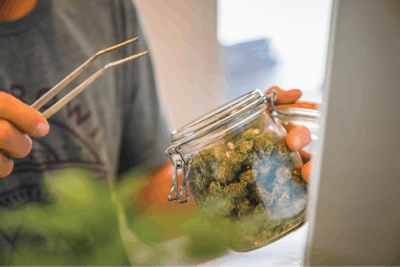
Long before Morris Denton applied for a medical marijuana cultivation license in the newly legal Texas market, he and his team had lined up a portfolio of business insurance policies.
Eventually, his company, Compassionate Cultivation, landed the first provisional license in the state’s vertically integrated marketplace. His due diligence on the insurance front helped pave the way for that success. To demonstrate financial wherewithal and risk management in the cannabis industry is to take the first steps toward compliance.
“As we were evaluating the opportunity,” Denton says, “one of the things that we had to look for was—on kind of a broad basis—what was going to be the impact financially on our business, especially in a small, narrow market like Texas, where our ability to drive revenue was going to be somewhat harnessed by the size of the market.” Furthermore, the political idiosyncrasies of Denton’s market forced him to think ahead. Texas legislative sessions meet biennially, so any tax projections (and their financial impact on the business) are in place for at least two years. (Other states meet annually and may adjust tax rates.) And while regulatory parameters vary from state to state—the need for a cannabis business to manage investments and keep risks low does not.
Any decision Denton made would need to factor in at least two years of the same tax burden. How much a business is willing and able to spend on insurance policies differs according to individual needs; a May 2018 Cannabis Business Times survey of licensed growers showed monthly premiums that ranged from $793 to $15,000 per month. “Part of the impact, from a cost perspective, is the cost of insuring the facility and the business, and so we had to factor that in during our [state] application phase,” he says.
Denton opted to go national, sensing that experienced firms with deep footprints in other U.S. cannabis markets would lead to a more robust relationship.
He went with Cannasure, a cannabis insurance company based in Northeast Ohio.
“The [insurance] application is pretty exhaustive,” Denton says. Detailed facility measurements were paired with the complex questions about security and cultivation that come with the cannabis industry. “They just … really want to understand what our business is,” he says.
Compassionate Cultivation’s 7,200-square-foot retrofitted facility in Manchaca, Texas (south of Austin), includes 2,500 square feet of canopy space and 2,500 square feet for processing and packaging.
Patrick McManamon, managing director of Cannasure, tells Cannabis Business Times that during an application review process he’s looking for signs that an applicant has put in the legwork to warrant underwriting. Things that help his analysis up front: newer construction and bigger facilities. (“We just find that sometimes the larger facilities can be more well-run, potentially,” McManamon says.) He also examines fundamental safety mitigation aspects of the business, like fire-suppression systems, water system automation, experience in the cannabis industry and geography. (States that limit the number of cannabis business licenses tend to support only the best and most well-designed facilities.)
The overarching red flags that give McManamon pause are uncertainty and ambiguity. If a business isn’t clear—or appears unknowledgeable—on a certain aspect of production, that’s a nonstarter. And outdoor cultivation is untenable for the insurer. “We just can’t insure the plants out there. Once they bring them inside, that’s a different story,” he says.
For Denton and his team at Compassionate Cultivation, it was the granular details about his business that got his application onto McManamon’s desk—and ultimately earned them a policy portfolio with the firm.
Norman Ives, cannabis program manager at Mosaic Insurance Alliance, LLC, says in other industries, insurance applicants complete applications to help the insurance company understand what it is insuring, because each business has a unique situation. In the cannabis industry, however, your application becomes attached to your policy.
“That doesn’t happen anywhere else in the insurance world—your application becomes a warranty, so if you make any incorrect statements on your application, you are eliminating coverage because you are providing contradictory statements,” Ives says.
Therefore, when completing insurance applications, business owners should work with an agent who can help them understand how to answer the questions, and the wording of the answers should be chosen carefully to avoid contradictory statements that can potentially void coverages.
It Takes Two
Mike Bush, partner at National Cannabis Insurance Services, says the cannabis industry has certain insurance nuances. “The devil is in the details in terms of the fine print … of what’s covered and what’s not covered,” he says, and he recommends that cultivators work with an insurance company that has expertise in the cannabis space, and an agent who can dig deep into the details of the policy to give the business owner a sense of what is covered.
Ives agrees that it is critical for cultivators to work with cannabis-specific insurance companies. “When it comes to cannabis insurance, this is highly specialized insurance. This is not something your average farmer’s agent would sell.”
For example, some types of coverage carry different terms in the cannabis industry, Ives says. Crop insurance for a tomato farmer would cover pests, for instance, but crop insurance for cannabis cultivators does not, nor does it cover outdoor crops.
In addition, cannabis operations are often structured differently than other agricultural businesses and may need two separate policies, one for the cannabis operation that touches the plant and one for the real estate entity, Ives adds.
Cultivators should also take the time to understand their business and risk exposures before they purchase coverage, Bush says. They should then base decisions on state requirements, whether the company is vertically integrated, corporate structure and the total value of the business, among other factors. Certain limits should also be evaluated, such as deductibles and payouts.
“You’ve got to think about this,” McManamon says. “What is your risk tolerance? What are you willing to self-insure?” he poses, referring to setting aside funds to cover potential losses instead of carrying an insurance policy.
Tim Conlon, cannabis practice leader at Industria Risk & Insurance Services, agrees that education is key for cultivators looking to get insured, and that business owners should not only use an insurance company specific to the industry, but also purchase coverage that will grow with them, which can be above and beyond the state-mandated minimums.
A major part of the insurer’s job, then, is to walk alongside the policy holder and identify clearly where any risks may exist. “A lot of these people have never had to buy insurance, either in their current business or businesses they’ve been a part of in the past,” Conlon says. “We really want to walk them down the path of … identifying where the risks exist [in their company or their operations], so we can … make them aware of what they’re looking at from an operational standpoint, which also then determines how to manage those and control those risks with certain insurance products that are available … so they’re not just allocating more money and more cash to replace something that was either stolen or burned down.”

Types of Coverage
Conlon says common coverage that cultivators should consider include:
- property and building coverage,
- worker’s compensation,
- general liability,
- product liability,
- professional liability,
- crop,
- stock,
- auto liability,
- cargo, and
- directors and officers insurance.
Business owners also should understand how each one aligns with their unique business, he adds.
“For worker’s compensation, for example, [that means] slips and falls and all the basic work injuries to employees, but [cultivators have] very specific chemical hazards,” Industria’s global lodging and leisure practice leader, Jana Wilson, says. And that is just one line of coverage; insurers must look at the entire operation to better understand a business and then guide the policy portfolio.
Bush urges his cannabis-industry clients to purchase not only general liability, but also product liability insurance, which covers cultivators, processors and dispensaries in the event a consumer files a claim that a product made her ill. Even though cultivators may seem far removed from the end product and the consumers who use it, they could be pulled into a claim and need defense coverage to cover the cost of an attorney and indemnification costs.
“The thing that … these guys aren’t thinking about is product liability,” Ives says. “If somebody says they’re sick—they don’t even have to really be sick, they just have to allege they got sick [from your product]—you are hiring attorneys to defend you against a health-related claim. That is expensive.”
And bankruptcy is not an option for cultivators facing debt due to a product liability claim, or any other uncovered claim, because cannabis is still a federally illegal industry, Ives adds. Bankruptcy cases cannot be filed in state courts.
Kevin Hogan, co-founder and president/COO of Oregrown, a vertically integrated cannabis operation in Oregon, says the company decided to purchase product loss and product liability coverage in addition to the general liability policy required by the landlords and the worker’s comp policy required by the state.
“We feel like the premiums are still relatively high compared to other industries, so outside of product liability and [product loss for] fire and theft, we’re not a big fan of other non-required endorsements,” Hogan says.
In most jurisdictions, like the city of Los Angeles, policies like product and general liability coverage are required—and owners may be assessed a certain range of fees for not complying with regulations. Workers’ compensation is often mandated by state law.
But when purchasing product liability coverage, cultivators should check for exclusions, particularly health hazard and impairment exclusions, Bush says. For example, if a state identifies cannabis as causing health hazards, and a cultivator’s insurance policy has a health hazard exclusion, coverage is void. Similarly, if an impairment exclusion exists, coverage could be jeopardized if someone were to consume a cannabis product and cause harm to property or another individual that resulted in a claim.
At its core, though, insurance coverage in the cannabis space comes down to a few basic concerns: “The No. 1 question we always get is: How much is this going to cost me?’” McManamon says. “Or, ‘Can I buy insurance for my plants?’”

The answer to the first question varies. The answer to the second question is an increasingly common “yes.”
At Cannasure, living plant coverage deals with fire, theft and vandalism to a grower’s indoor crop. McManamon says that his company isn’t insuring against mold infestations or spider mites, although that type of coverage may be on the table in the future. “That’s always one people are always looking for,” he says.
Nonetheless, the starting point for crop insurance at this point in 2018 is an indoor or fully enclosed greenhouse operation.
When purchasing crop insurance, the cultivator provides the insurance company with the value of the crop from seed to harvest and end product, so if loss occurs at any stage, the cultivator can file a claim and the insurance company can quickly identify the amount of coverage, Bush adds. Fire, hail, lightning, smoke and theft are generally covered by crop insurance, while fungus, rot, mold and human error are not.
“I explain to people, look, you lose your crop, you lose your business as a cultivator,” Bush says. “There’s no fall-back, no lifeline, and … you have to ask yourself, if you were to lose your harvest, are you really able to sustain, let’s say, three to six months [with] no revenue while you replace your building and … your harvest?”
And while it’s a growing trend, not all indoor cultivators will see the need. The decision comes back to individual costs. Since processing and retail are the main components of Compassionate Cultivation’s business, for instance, the company declined crop insurance.
“It’s not like [live cultivation] isn’t a significant part—obviously, it’s a key component to what we do—but it’s not the entirety of what we do,” Denton says. “We’re an all-indoor grow, as well. We feel pretty confident with … the strategy for how we’re growing and the ability to mitigate any potential loss associated with that.”
Internal risk mitigation was a central feature of the illicit cannabis trade. Before laws were enacted to support legal cannabis commerce, there were, of course, no insurance policies available. And even in today’s nascent marketplace, judicial inroads have provided certain precedents in how the discrepancies between state and federal law play out.
The Legalities
A landmark ruling came in 2016 in Green Earth Wellness Center, LLC v. Atain Specialty Insurance Company. A federal judge ruled that an insurance company couldn’t back out of a claim filed by a cannabis company on the basis that the policyholder worked in a business deemed illegal by the federal government. (The companies were operating within Colorado.) “Atain, having entered into the Policy of its own will, knowingly and intelligently, is obligated to comply with its terms or pay damages for having breached it,” the judge ruled.
In a case that set a degree of precedent in the insurance world, the judge leaned heavily on the nature of state law. The judicial order even points out that the policy itself “seems to suggest that disputes between the parties will be governed by the law of the state in which the suit is brought—here, Colorado.”
The Green Earth suit set the tone for further disputes in most other states governed by rules similar to Colorado’s early adoption.
“A couple of years ago, we would have had a lot more questions than we do now,” McManamon says.
“Now, it’s kind of standard business. People understand the insurance a little bit more. They understand that it’s available to them, and we just walk through the different coverages.”
Still, it wouldn’t be the cannabis industry without roiling uncertainty. In January, U.S. Attorney General Jeff Sessions rocked the business with his rescission of the Cole Memo, removing a layer of protection from licensed business owners in state-legal markets. While investments took a brief hit over the winter, the move didn’t outright affect how insurance providers engaged their clients. And yet, questions persisted anew. (“We can’t provide coverage from [asset seizure or other prosecution by] the federal government,” McManamon says. “That’s another one we get quite often.”) Cannasure and other providers do offer forms of “raid insurance,” which protect against state and local asset seizure, say, at a temporary cannabis event or festival. It’s another example of how providers are adjusting to this new and rapidly evolving industry.
“We’re still learning,” Denton says. “This is so new to us, and [we’ve been] trying to understand the different complexities that are involved and how insurers look at our business. We have taken the time to meet with a variety of different insurers and educate them on our business—and allow them to educate us on how they view our business and how they view our industry in total. Having a good understanding and appreciation for how all that fits together, I think, gives you a good idea of how to engage and potentially negotiate with an insurance company.”
Melissa Schiller is the Assistant Digital Editor for Cannabis Business Times and Cannabis Dispensary








_fmt.png?auto=format%2Ccompress&fit=crop&h=141&q=70&w=250)








